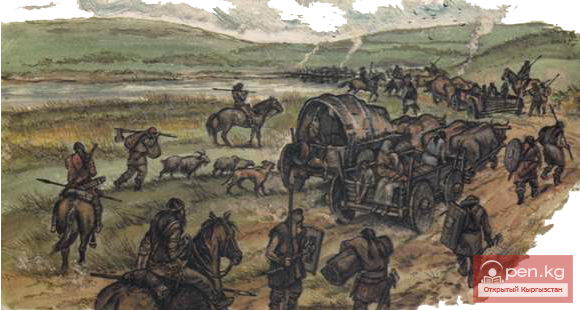
The study of ethnogenetic information of nomadic tribes has been significantly contributed to by...

The sanjyra, as a historical source, consists of a structure made up of legendary and several...

The glasnost of the perestroika period opened new opportunities for the study and popularization...

The analysis shows the continuity of historical and genealogical information in the sanjyra. A...

Sanjiра is an oral chronicle that reflects the genealogical branches of individual clans, tribes,...

Genealogy is the “tree of life” of a person. The Turks, including the Kyrgyz, who, due to their...

Legends. In the first half of the 12th century, it is likely that the "Karakhanid"...

Ichkiliki and Arkalyki. The name "Ichkiliki" may have originated from the ancient Turkic...

Ethnic Situation in the Tian Shan in the Middle Ages A comparative analysis of sources and early...

In the sources, up until the 18th century, there is little information about the clan-tribal...

Ulus Inga-Tyuri During military clashes, it appears that part of the "Central Asian"...

Ibrahim ibn Ahmed and Anal-Hakk Thus, the "progenitor" of the Kyrgyz ethnicity of the...

Belek Soltonoev Soltonkeldi Uulu (1878-1938) - historian, educator, writer, rightly recognized as...

The First Enlighteners: Ishenaly Arabayev, Ibraim Abdyrahmanov After Kyrgyzstan joined Russia,...

Writings of "Shajarat al-Atrak" In the anonymous work "Shajarat al-Atrak,"...

Kyrgyz Division into Tribes and Clans Despite the absence of a centralized state, the Kyrgyz had...

The food culture of the Kyrgyz has a deep history. The formation of its main ethno-cultural...

The Jogorku Kenesh of the Kyrgyz Republic, having reviewed the state of the Manuscript Fund of the...

Kutano Askar Asanbekovich Doctor of Technical Sciences, Professor, Academician of the National...

Bais, Biis, and Manaps The measure of wealth and the main equivalent in trade and economic...

During the period in question, Kyrgyzstan was unable to conduct any foreign policy. However,...

Kyrgyz of Afghanistan. The settlement of the Afghan part of the Pamir by Kyrgyz began in the...

Alybakov Askarbek Alybakovich Doctor of Physical and Mathematical Sciences, Professor,...

The Last Eastern Karakhanid Khans. According to the information from "Majmu...

LETTER FROM THE CHIEF MANAP DJANTAY KARABEKOV TO THE BORDER COMMANDER OF THE SIBERIAN KYRGYZ...

Protoichkiliks and Arka These accounts may refer to the separation of a certain part of the tribes...

The formation of the Kyrgyz people is connected with ethnic processes in ancient and medieval...

COMPETITION The famous Russian scientist P. P. Semenov (Tyan-Shansky) during his journey to...

Hunters with Golden Eagles. Mountain Semirechye, Kyrgyzstan. 1926. HUNTING Hunting has been an...

“The Kyrgyz Tribe Named Itself Oghuz-Khan” The clan-tribal structure of the Kyrgyz of the right...

The Kyrgyz are one of the oldest peoples who lived in Central Asia and roamed the vast expanses of...

One of the largest Soviet Orientalists, Academician V. V. Bartold, classified the Kyrgyz among the...

Seydene Moldoke kyzy (born 1922) — an outstanding storyteller, one of the few women-manaschis. She...

Zhumaliev Kubanychbek Myrzabekovich Doctor of Technical Sciences, Professor, Academician of the...

A city of representatives of more than 80 nationalities During the years of Soviet power, as...

Kyrgyz of Fergana Together with Uzbeks Created the Kokand Khanate Every person, no matter how...

Maripov Arapbay Doctor of Physical and Mathematical Sciences, Professor, Honored Scientist of the...

Brief information about Taylak has been preserved in Chinese chronicles of the 19th century, and...

One of the main characters of oral folk art....

Works of Medieval Authors The work "Shajaray-i Turk va Mogul" ("Genealogy of the...

Other lines of connections among the Kyrgyz are significant, especially the ethnic ties with the...

The Presence of Numerous Clans and Tribes Among the Kyrgyz People Life for a Kyrgyz outside the...

The family is the most important institution in the system of social relations in Kyrgyz society....

It is known that in the 18th century, the Kyrgyz, although rarely, used a new writing system, as...

In times long past, there lived a famous Kyrgyz manap, Ormon, a person of strong will, very...

The Study of the Kyrgyz Continues in Modern Conditions In the 40-plus years since the publication...

Much larger areas than deserts and semi-deserts are occupied by steppes in Kyrgyzstan, which are...